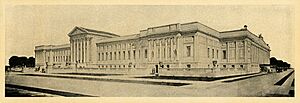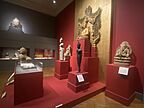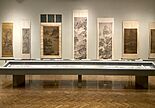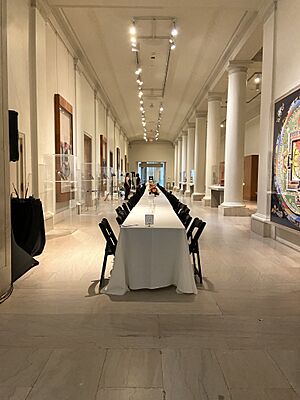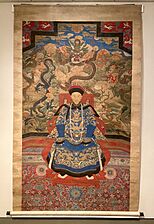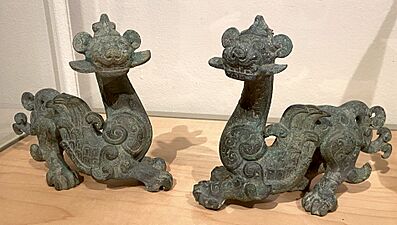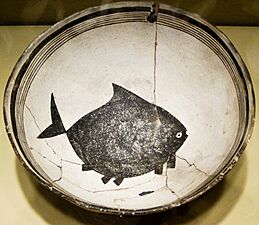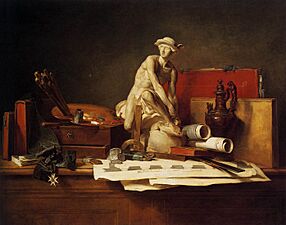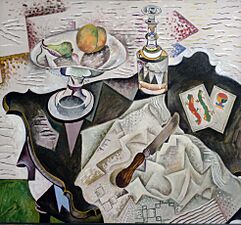Minneapolis Institute of Art facts for kids
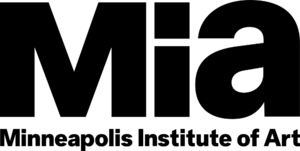 |
|
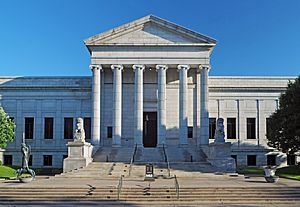
Mia viewed from the north
|
|
| Lua error in Module:Location_map at line 420: attempt to index field 'wikibase' (a nil value). | |
| Established | 1883 |
|---|---|
| Location | 2400 Third Avenue South Minneapolis, Minnesota |
| Collection size | 90,000+ |
| Visitors | 591,069 (2022) |
| Public transit access | Metro Transit Bus: 11B, 11C, 17, 18 |
The Minneapolis Institute of Art (Mia) is a large art museum in Minneapolis, Minnesota, United States. It holds over 90,000 pieces of art. These artworks show 5,000 years of world history. Mia is one of the biggest art museums in the United States. Its collection covers about 20,000 years. It represents many different cultures from six continents.
The museum has seven main art areas. These include art from Africa and the Americas, modern art, and Asian art. There are also sections for decorative arts, paintings, photography, and prints. More than half a million people visit Mia each year. Many more learn through its Art Adventure program for kids. The museum offers free general admission. It also has public programs, classes for all ages, and interactive media.
Contents
History of Mia
The Minneapolis Society of Fine Arts started in 1883. Its goal was to bring art to the community. This group, made of business leaders, held art shows. In 1889, the Society became the Minneapolis Institute of Art. It moved into its first permanent home. This was inside the new Minneapolis Public Library.
The institute received gifts for its new building. Clinton Morrison and William Hood Dunwoody were among the donors. In 1911, Morrison gave the land. It was where his family's mansion used to be. He gave it in memory of his father, Dorilus Morrison. This gift came with a condition. The institute needed to raise $500,000 for the building. Just days later, Dunwoody pledged $100,000. A fundraising dinner soon after raised $335,500 in only 90 minutes.
Building Design and Growth
The new museum opened in 1915. It was designed by the firm McKim, Mead and White. The building became known as a great example of Beaux-Arts architecture in Minnesota. The art historian Bevis Hillier held an exhibition called Art Deco there in 1971. This show helped bring back interest in the Art Deco style.
The original plan was for the building to have several parts. But only the front section was built at first. Later, new parts were added. Kenzo Tange designed an addition in 1974. An expansion by Michael Graves was finished in June 2006. Before this last expansion, only 4% of the museum's art could be shown. Now, about 5% of the nearly 100,000 objects are on display. Target Corporation was the biggest donor for the new wing. They gave over $10 million.
In 2015, the museum changed its name slightly. It became the Minneapolis Institute of Art. It also started using the nickname Mia more often.
Museum Leadership
Kaywin Feldman became the director in 2008. During her time, museum visits doubled. She also focused on digital access to art. She started programs about social justice and fairness. In December 2018, she was chosen to lead the National Gallery of Art. She started that job in March 2019.
In October 2019, Katherine Luber became the new director of Mia. She had previously worked at the San Antonio Museum of Art.
Mia's Art Collection
Mia has a huge collection of about 100,000 art pieces. These works cover 5,000 years of world history. The collection includes paintings, photographs, prints, drawings, and textiles. It also features architecture and decorative arts.
There are special collections of African art and art from Oceania and the Americas. Mia is especially known for its Asian art collection. This collection is called "one of the finest and most comprehensive Asian art collections in the country." It includes Chinese architecture, jades, bronzes, and ceramics.
The institute also owns the Purcell-Cutts House. This house is a great example of Prairie School architecture. It was given to the museum by Anson B. Cutts Jr. You can take tours of the house on the second weekend of each month.
Museum Services and Programs
Mia offers many services and programs. The museum has "affinity groups." These groups help people who collect art. They also help the museum get important new artworks. The groups hold talks, workshops, and trips for their members.
The museum often hosts special exhibitions. These shows bring in art from other museums. Local businesses often help pay for these exhibitions. Sometimes, the artists themselves give tours of their work.
Mia is also home to the Minnesota Artists Exhibition Program. This program is run by artists. It focuses on showing works by artists who live in Minnesota. The Museum Library has over 60,000 books about art. The library is open for everyone to use.
Outdoor Art and Sculptures
The museum has several art pieces outside its building.
- Chinese Lions: Two Chinese lions sit at the 24th Street entrance. They were a gift in 1998. New lions were carved in China in an old style.
- The Fighter of the Spirit: The bronze statue The Fighter of the Spirit by Ernst Barlach is near the 24th Street entrance. It shows a winged man holding a sword. He stands on a snarling beast. This statue was once hidden during a difficult time in history. It was later repaired and copies were made. Mia got one copy in 1959.
- Chinese Garden: The Chinese Garden can be seen from the museum's café. It has special Taihu stones. These stones are said to look like mountains. The garden was a gift from Ruth and Bruce Dayton.
- Target Park: This park is behind the museum. It has several modern statues. These include works by Pietro Consagra, Richard Erdman, and Jean Willy Mestach. There is also a granite and steel pavilion called Labyrinth. You can look up through cuts in its roof to see the labyrinth design.
- Eros Bendato Screpolato: To celebrate its 100th anniversary, Mia bought a sculpture by Igor Mitoraj. This bronze sculpture is called Eros Bendato Screpolato. It is one of a series of "bandaged heads" by the artist. Similar sculptures can be found in other cities.
Museum Finances and Support
The William Hood Dunwoody Fund helps Mia buy new art. This fund started with one million dollars in 1914. It has helped the museum buy thousands of artworks. Bruce Dayton, a long-time trustee, made sure money raised for the Target wing was also used for art purchases. This fund, now at $91 million, has helped Mia buy rare items. These include an early 18th-century Native American painted buckskin shirt. It also bought a huge map of Venice from 1500.
In 2009, the museum's $145 million fund decreased by 21%. This fund usually provides about one-fifth of the museum's money. Gifts from people and companies make up another quarter. Almost half of Mia's operating money comes from a special tax fund. This "park-museum fund" started in 1911. It provides public support because the museum offers free admission. In 2010, this fund gave the museum $12.6 million. In 2011, the museum's yearly budget was $24.6 million.
In August 2016, the museum received a $6 million gift. This money was for the Gale Asian Art Initiative. This program helps show off Mia's large collection of Asian art. The gift came from Alfred P. Gale. The first show for this initiative was Ink Unbound: Paintings by Liu Dan. A modern Chinese artist, Liu Dan, was asked to create a new ink painting. He based it on an old Dutch painting in the museum's collection.
Art with a Special History
Sometimes, museums work to understand the full history of their art. In 2008, Mia returned a painting called "Smoke Over Rooftops" by Fernand Léger. It went back to the family of a Jewish collector whose art was taken during World War II.
In April 2024, there were discussions about a Roman statue called the Stabiae Doriforo. Italy believed this statue had been taken from an ancient site. Mia had bought the statue in 1986. The museum stated that it believed it had acted carefully when getting the statue.
Selected Artworks and Paintings
-
Henri Matisse, 1907, Les trois baigneuses (Three Bathers), oil on canvas, 60.3 x 73 cm, The Minneapolis Institute of Arts.jpg
Henri Matisse, Les trois baigneuses (Three Bathers), 1907
-
El Greco (Domenikos Theotokopoulos) - Christ Driving the Money Changers from the Temple - Google Art Project.jpg
El Greco, Cleansing of the Temple, 1571
-
Jean Siméon Chardin, The Attributes of Art, 1766
-
Joan Miró, Les cartes espagnoles (The Spanish Playing Cards), 1920
-
Vincent van Gogh, Olive Trees Saint-Rémy, November 1889
-
Rembrandt van Rijn - Lucretia - Google Art Project (nAHoI2KdSaLshA).jpg
Rembrandt's Lucretia, 1666
-
Paul Gauguin, Under the Pandanus II, 1891
-
Fernand Léger, Le compotier (Table and Fruit), 1910–11
-
Doryphoros MIA 866.jpg
Doryphoros (the Spear Bearer)
See also
 In Spanish: Instituto de Artes de Mineápolis para niños
In Spanish: Instituto de Artes de Mineápolis para niños
- List of largest art museums
- List of most-visited museums in the United States


